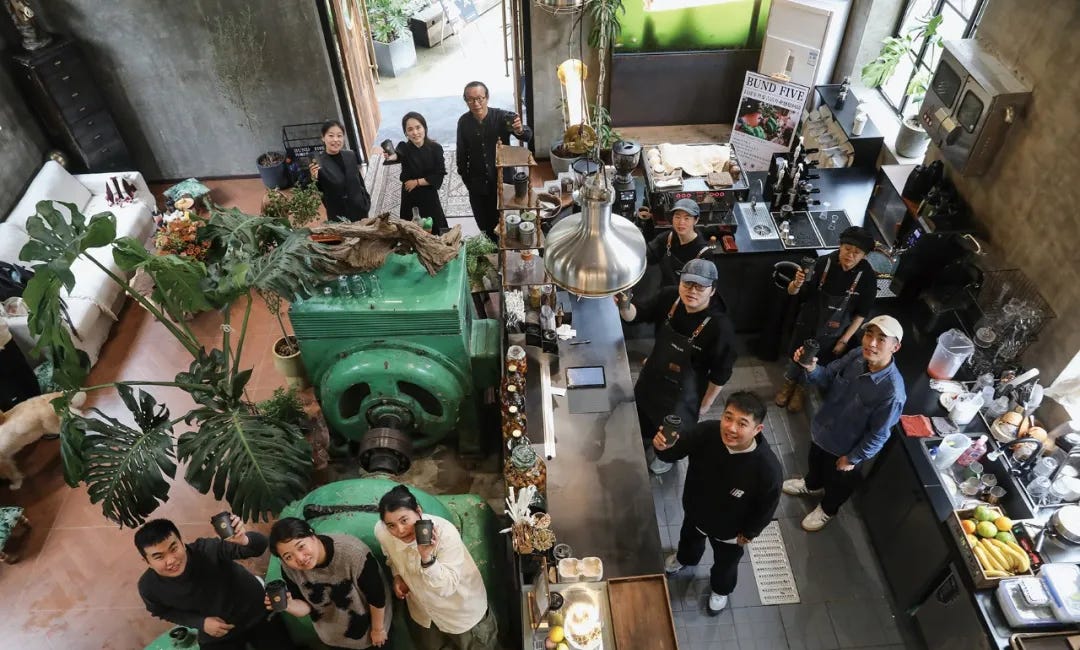In our previous newsletter, we discussed how China's lower-tier cities have become a bigger growth driver of domestic consumption, compared to first-tier cities where momentum has slowed.
Only 6% of China's population lives in first-tier cities (Beijing, Shanghai, Shenzhen and Guangzhou). The vast majority experience a very different lifestyle. To truly understand China, we need to look beyond Beijing, Shanghai, Guangzhou, and Shenzhen, and pay attention to the lower-tier cities that often go unnoticed.
In fact, the gap between first-tier and lower-tier cities is still widening. H1 2025 data shows a clear contrast: retail sales in Beijing fell 3.8% year-on-year to RMB 673.4 billion; Shanghai grew just 1.7%, and Shenzhen rose 3.5%—all below the national average of 5%.
The restaurant sector looks even weaker in first-tier cities. In H1 2025, Beijing's restaurant revenue dropped 3.6% and Shanghai fell 2.6%. By contrast, most second-, third-, and fourth-tier cities recorded positive growth. The same pattern is shown in auto sales—down in Beijing and Shanghai, but up by double digits in many smaller cities.
One reason is migration patterns. For instance, in a previous newsletter we discussed how young Chinese are moving back to their hometowns in smaller cities and counties, where affordable housing offers a much better work-life balance. Many returnees have brought big-city tastes, habits, and mindsets with them, reshaping the local lifestyle.
Many young Chinese even took this a step further by starting their own businesses in smaller towns. In 2023, as China emerged from COVID, a wave of young people and recent graduates—frustrated by the tough job market and grueling work hours—jumped into what became known as "spur-of-the-moment, passion-fueled entrepreneurship." They moved to smaller cities where rent and labor costs were far lower, launching cafés, fitness studios, design workshops, boutique stores, and content creation studios, just to name a few examples. They transplanted the ideas and aesthetics they had absorbed in big cities into smaller towns, where these styles still felt fresh and fashionable.
For instance, in a previous newsletter we covered Anji, a small county of fewer than 600,000 people in Huzhou, Zhejiang Province, where more than 300 boutique coffee shops have opened. Each has its own distinctive design, personality, and the personal story of its owners. On a per capita basis, Anji now has even more coffee shops than Shanghai—a city famous for its bourgeois-chic cafés on almost every corner.
The coffee wave: Gen Z's impact on China's rural lifestyle
We’ve heard from many of you that our coverage of China feels refreshingly comprehensive. That’s because we don’t just focus on the usual suspects—Beijing, Shanghai, and other big cities—but also on the places where most people actually live. Only 6% of China’s population resides in first-tier cities, meaning the vast majority experience a very differen…
However, simply transplanting the "big-city" lifestyle into a smaller town isn't a universal solution for all entrepreneurs. Recently, a widely shared WeChat article titled "The first batch of middle-class returning home to open 'Village Cafes' are back to the grind" sheds light on the less optimistic aspects of these entrepreneurial endeavors.
Many entrepreneurs who returned to their hometowns to start businesses like village cafes are now returning to their urban jobs. I translated the highlights of this article below:
In the scorching heat of August, I met my close friend Ruolan at a Starbucks in Wangjing (a district in Beijing).
She was a former colleague from a media company I worked at in Hong Kong, and also once a "village café entrepreneur." From the south to the north, we shared similar career paths.
Until over two years ago, she escaped from the high-pressure work life in Beijing and returned to her hometown in Shanxi, drawn to the idea of rural living. There, she opened her first "village café," and that marked a new direction in our lives.
Before starting her business, Ruolan had passionately told me: "Maggie, I want to open a café in the countryside, create an idealistic business."
However, today, sitting across from me, she's back in a professional outfit and high heels, her smile tinged with a sense of helplessness.
"You see, I'm back again," she laughed, pointing at the iced Americano in front of her. "This isn't the coffee I dreamed of, but at least it helps me get through the monthly bills."
Through her fragmented description, I roughly understood her entrepreneurial journey.
From the moment she entered the "village café" track, she held on for 26 months, with a loss of over 650,000 RMB. It wasn't an astronomical number, but enough to make Ruolan lose hope.
So, this Americano in front of me, when compared to the scene of her pouring her heart into every cup of hand-drip coffee at her rural café last year, truly evokes mixed feelings.
"At first, I thought that as long as there's coffee, an ancient village, and cave dwellings, I could win," she said. "But the reality is that this industry is far more complex than I imagined, and the problems behind it were far beyond my expectations."
Two years ago, when pandemic restrictions were lifted, urban "internet sensation" cafés suddenly fell out of favor. More and more people started visiting nearby rural areas to unlock a new experience—"village cafés."
The cafés in these villages, whether hidden in tea fields or set in ancient village houses, carried the fragrance of the earth mixed with the aroma of coffee. First-generation "internet-sensation village cafés" like Waterfall Café and Deep Blue Plan even generated over 100 million RMB in revenue in Zhejiang's Anji County in one year.
Ruolan's first café, located at the junction of Shanxi and Hebei in an ancient kiln village, was beside a national highway. It was about two hours' drive from Taiyuan and Shijiazhuang (Baiguan: Taiyuan and Shijiazhuang are two municipal capitals and metropolitans nearby), with relatively convenient transport. The village had several newly opened homestays, so the overall environment was decent.
She personally oversaw the renovation: painting the walls, moving tables, putting up the menu, investing nearly 700,000 RMB, including equipment, soft furnishings, outdoor flooring, and a bunch of Instagram-worthy green plants for photo ops.
"At that time, who didn't dream of growing flowers while selling coffee?" she said.
When it first opened, the café was indeed popular. During the Qingming Festival and Labor Day, many people on social media shared pictures of her café. She told me that they sold around 2,000 RMB a day, with at least 70% profit.
But the problem was that she only accounted for the holiday sales and overlooked the reality of the other 300 days.
Her village had fewer than 1,000 permanent residents. Most young and middle-aged people worked elsewhere, leaving behind mainly the elderly and children. Hardly anyone consumed coffee daily.
The real customers were young people from surrounding cities who came by car, but they only came during holidays. After taking photos, they rarely visited the second time.
"Essentially, I was selling the scenery, not the product or the experience," Ruolan said. "It's like building a stage set. The actors came on once, and then the play was over."
Business started declining from the first summer. In July, after heavy rain, she closed the café for a week, and by August, there were barely any customers left. "We couldn't even sell five cups a day, and the ice was melting white," she said.
After the National Day Golden Week that year, she started to subsidize the business, using savings and hoping that things would get better next month.
By June this year, she couldn't hold on any longer.
In the evening that she closed the café, she posted on social media: "Thanks to the friends who came, and thanks to those who didn't. The wind blew through the ancient kiln, and it also awakened me."
The comment section was full of regret, but this wasn't an isolated case for a single "village café." It was a collective dilemma in the entire sector.
When "village cafés" became a new magnet for internet traffic, they also became the urban fantasy projected onto the countryside.
It sounded nostalgic, poetic, and had a business model. But once it was implemented, many realized that reality was far colder than the filter—perhaps even indifferent.
[...parts abbreviated]
As she closed the café, Ruolan reflected, "I didn't make a mistake in starting the village café, I just took the wrong direction and chose the wrong location."
I agreed with her on this.
When everyone uses an Instagram filter and picture-taking as a template, consumers quickly become numb.
By the end of 2024, a team from the travel industry surveyed more than 30 popular village café areas in counties across China. We found that over 60% of village cafés were barely surviving or had closed within six months.
New shops are opening faster, and more equipment is being sold off. The few that are able to sustain themselves aren't doing so by relying on viral products—they're doing so through their sustaining ecosystems.
The business of cafés itself isn't wrong, but the mistake is when too many people think that just having rice fields, swings, and a hand-drip coffee pot can harvest a generation's pastoral nostalgia.
Indeed, there are a few success stories, such as Deep Blue Plan in Anji, Tao Café in Ma Wangxi, and Rice Milk Coffee in Lakebei Village, Jiangxi, which gained fame through natural scenery, unique settings, and industry integration.
But this doesn't mean you can replicate their success by simply setting up a white wall, a swing, and hanging some bulbs at any village.
[...parts abbreviated]
The true success stories are not about the label "village café," but those few who possess long-term vision, organizational capabilities, and the ability to integrate resources.
The issue now is that "village cafés" are already beginning to devolve into the "involution" (Baiguan: "involution" refers to excessive, often self-defeating competition and overwork).
You film a rice field video, and someone else shoots an aerial view of terraced fields. You post a swing in front of a white wall, and someone adds a glass dome with a rotating swing chair. You share a hand-drip coffee art, and someone is live-streaming their coffee bean grinding and acidity testing. You've just finished writing your caption, and others already have 50 posts about it on Red Note.
Does it really imply that the future of young entrepreneurs in rural and lower-tier cities has come to an end?
I think the takeaway isn't necessarily that China's smaller towns have lost their growth potential, but rather that it highlights how rapidly Chinese consumer markets evolve. In the beginning, novel lifestyles and aesthetics brought from big cities may have easily won over smaller-town consumers. However, once the novelty fades, consumers quickly start demanding more.
This isn't just an issue for café owners; it's prevalent across many industries. I mentioned this earlier with the example of some "ancient town" tourist attractions, which were quickly built with massive government support to model successful examples. However, many of them are now going bankrupt in bulk and becoming ghost towns. Towns without the required cultural legacies to support such attraction sites simply won't survive once the initial novelty fades.
China's large consumer market makes it easy to "copy and paste" a successful model and see some quick wins, but for cities or entrepreneurs who don't consider the unique aspects of their business or location, these ventures will fade quickly.
For instance, in today's Chinese consumer market, the guaranteed "quick win" for merchants is to set up fancy, novelty scenes for consumers to take social media-worthy photos. This strategy has been so effective in attracting customers that it's now common to see people waiting for hours just to take a picture. In just a few years, hundreds of thousands of boutique shops with these setups have appeared across China. But sooner or later, consumer fatigue sets in, and those that only rely on "Instagrammable" setups without real personality or unique offerings will be quickly squeezed out.
Lastly, the story of "rural cafes" shows that much of rural consumption still benefits from the trickle-down effects of first-tier cities. For example, if the aforementioned Anji were not close to the metropolitan Hangzhou area (only ~1.5h ride), the 300 rural cafes would likely have very different fates.
Lower-tier cities often lag behind big cities in chasing fashionable lifestyle trends as well as in "feeling the social and economic temperature." For smaller cities, especially those that rely on tourism from nearby metropolitan areas, the further deterioration of consumption in first-tier cities is certainly not a good news for them.
Looking to the future of China, I believe there will be a bigger cohort of talented entrepreneurs who can combine their unique passions with business to create long-lasting companies. The consumer market has entered a phase where people are growing tired of visiting the same "copy-and-paste" locations and taking photos just to check things off a list.
For example, in recent years, staycations are becoming more popular among middle-class Chinese who aren't interested in social media photos when they travel and avoid "influencer hotspots" altogether. People are increasingly seeking one-of-a-kind stories and experiences, even in a slower economy.
The sheer speed at which Chinese consumers can change determines that much of the "involution" problem is caused by the inability to keep innovating, not by a lack of demand growth. In today's China, you'll increasingly hear people say, "There's really nothing I want to buy; many products just look boring".
This is the other side of China's so-called "involution" problem—excessive, often self-defeating competition. Frankly speaking, the "involution" phenomenon, often reported in the manufacturing and physical goods sectors, is by nature not that different from what's happening in experiential spending and service.
On one hand, there's the imbalance between supply and slower demand growth (and, of course, the declining overall population); but on the other, Chinese consumers' cycle of chasing novel products and experiences evolves so quickly that any "successful" business template can become outdated and turn into a commodity, a homogenized version of itself, in just a few years.









